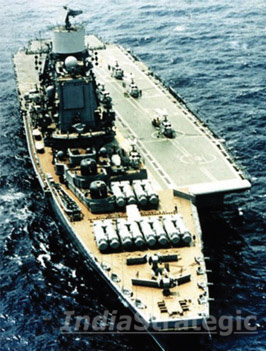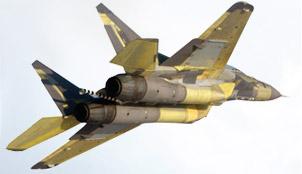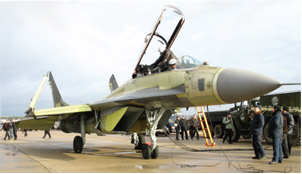
Moscow. In early May, an Indian naval delegation headed by Vice Admiral Birinder Singh Randhawa, Controller of Warship Production and Acquisition at the Integrated Headquarters, Ministry of Defence (Navy), visited Severodvinsk, a major submarine construction centre in the Arkhangelsk Region, northern Russia.
In spite of cold temperatures, piercing winds and snowfalls, the visit proved very fruitful. The delegation visited the local Northern Engineering Works (Sevmashpredpriatiye) and inspected the Mk 1143.4 Admiral Gorshkov aircraft carrier, now being refitted under a bilateral contract. The aircraft carrier, due to be renamed the Vikramaditya after a famous Indian king, is expected to enter service with the Indian Navy in August 2008.
Vice Admiral Randhawa was very pleased with the visit’s results and noted many changes in the warship’s upper-deck structures and interior. Although the Admiral Gorshkov’s modernisation is somewhat behind schedule, Mr. Randhawa said this extremely difficult project would face problems from time to time. But he said he saw that Sevmashpredpriatiye was doing its best to solve them in time.
WHAT IS THE ADMIRAL GORSHKOV?
On December 26, 1978, the keel of the Mk 1143.4 Admiral Gorshkov aircraft carrier was laid at the Nikolayev shipyard in Ukraine. The 273-metre long warship displaces 48,500 tonnes, has a beam of 49 metres and a 10.2-metres draught. The carrier can cruise along at 30.7 knots, has a 30-day sea endurance and a 1,610-man crew.
She entered service with the Soviet Navy in December 1987 and was assigned the task of guarding strategic missile submarines. For that purpose, the Admiral Gorshkov operated 14 Yakovlev Yak-141 Freestyle vertical take-off and landing (VTOL) fighters, eight Yak-38 Forger VTOL fighters, as well as 16 Kamov Ka-25 and Ka-252RLD Hormone and Ka-252PS Helix anti-submarine warfare (ASW), reconnaissance and search-and-rescue helicopters.
Moreover, the aircraft carrier, which supported warship formations and naval strategic bombers in combat areas, was supposed to attack enemy aircraft, warships and submarines. For this purpose the Admiral Gorshkov had 12 Bazalt anti-ship missile launchers, six tentube Udav-1 anti-submarine rocket mortars, four torpedo tubes, as well as four Klinok air-defence systems comprising 24 launchers, two 100- mm AK-100 guns and eight 30-mm AK-630 anti-aircraft guns.
However, it turned out that VTOL fighters did not correspond to specifications, carried small ordnance loads, had a short combat range and crashed rather often. The disintegration of the Soviet Union and subsequent financial shortages made it impossible to eliminate these drawbacks. These warplanes were scrapped, and the Admiral Gorshkov had to be berthed.
The warship could have suffered the same sorry fate as her sister ships, namely, the Kiev, the Minsk and the Novorossiisk, that also carried Yakovlev fighters, and which were eventually sold for scrap. However, the Indian Navy took an interest in the Admiral Gorshkov and therefore prevented her destruction.
Moscow and New Delhi negotiated the carrier modernisation contract for many years. The Indian side insisted that Russia charge less for overhauling the Admiral Gorshkov. According to some rumours, the warship was sold to India as scrap metal, that is, for $150-200 per tonne. Moreover, New Delhi insisted that the Russian carrier be upgraded in order to accommodate horizontal take-off and landing fighters, and that its arsenal should include weapons popular with the Indian Navy. Moscow accepted all these proposals.

The $1.5 billion Gorshkov modernisation contract was signed in 2004. The total overhaul expenses amounted to $600-700 million. The rest will be spent on deck fighters, equipment and weapons from third parties. The Nevskoye Design Bureau in St Petersburg, which had developed the Admiral Gorshkov, submitted the modernisation project. The warship is being overhauled at Sevmashpredpriyatiye in Severodvinsk.
All redundant artillery systems and missiles, including Bazalt launchers and AK-100 guns, will be removed during the project’s initial stage. All other weapons, namely, Klinok airdefence systems, AK-630 anti-aircraft guns, and most radio-electronics and specialised equipment will also have to go.
Instead the Admiral Gorshkov is to receive new-generation air-defence systems, whose specifications are not known yet. The initial modernisation stage will end after obsolete machinery is replaced with up-todate equivalents. After that, New Delhi will become the ship’s legal owner.
During the second stage, India will list all the required weapons and equipment for the Vikramaditya. Her upper deck will be extended until the bow section, and a 14-degree 20- metre-wide ramp will be constructed there.
The 280-metre flight deck will have a 198-metre runway for operating Mikoyan-Gurevich MiG-29-K Fulcrum supersonic fighters chosen by India.
The 24-metre-wide runway will feature three arrester wires, and there will also be a 130 by 23 by 5.7-metre hangar below the deck. The hangar will have a 30-tonne 18.91 by 9.96- metre lift located amidships left of the island superstructure and a 20-tonne 18.91 by 8.65-metre lift behind the superstructure and in front of the arrester wires. The top-deck aircraft parking area will measure 2,400 square metres. The Vikramaditya will therefore become one of the best aircraft carriers in her class.
BEST RUSSIAN WARPLANES
In February 2007, Indian pilots and sailors were quite impressed to see the single-seat MiG-29K Fulcrum deck fighter and the two-seat MiG- 29KUB deck trainer/combat plane at an airfield in Zhukovsky near Moscow. “We have known about the top class MiG warplanes for a long time, but the MiG-29KUB that was developed by Russia for India is even better,” said Commander Jasvinder Chauhan, India’s Air Force Attaché in Moscow.

This statement is no exaggeration because Indian experts had teamed up with designers and engineers of Russia’s MiG Aircraft Corporation to develop the MiG-29KUB. They listed all the required specifications, which were embodied in the warplane.
In some cases, Indian specifications may have seemed exorbitant because they exceeded the best achievements of the global aircraft industry. However, MiG complied with the requests of its clients. The Indian side helped to integrate foreign electronics into the plane’s avionics, to develop simulators and to choose the required weaponry.
Nikolai Buntin, chief designer of the MiG-29KUB project for India, said the Rusian Air Force and Navy lack such good planes. The MiG- 29-KUB’s radio-electronic system features the French-made Thales TopSight helmet-borne sighting device and the Sagem Sigma-95 laser-gyroscope inertial navigation system. Thales TopSight is, in fact, a shock-resistant helmet that will protect the pilot if a bird shatters the cockpit canopy. Its sighting device is activated by a movement of the head. The fighter’s unique open-architecture and modular-system avionics will not become obsolete in the next ten to 15 years. Only separate components of the MiG-29KUB’s radio-electronic system will have to be replaced if the need arises.
This radio-electronic system is an upgraded version of the one installed on the MiG-29SMT fighter, also serving with the Indian Air Force. It retains the MIL-1553B-type bus, to which the plane’s electronics are attached, and four-channel multiplex settings. Nikolai Buntin said the MiG-29K has a more sophisticated multiplex bus than other Russian planes being sold elsewhere. He added that the MiG-29KUB’s vital systems feature fibre optic communications channels.
Fibre channels and fibre optic lines expedite data-exchange speeds 100 times over and enable the pilot to outmanoeuvre and outgun the enemy. No MiG warplane has ever had any high-speed data-exchange channels before. All three multi-purpose MFI10-6 data screens in the MiG- 29KUB’s front and rear cockpits, the IKSH-1K heads-up display (HUD) and the Thales TopSight sighting device/ target-acquisition system receive video information from the Fazotron- NIIR radar, the new-generation Zhuk- ME optronic radar, other sighting and radio-electronic warfare systems and the built-in digital terrain contour matching (TERCOM) map along fibre channels.
The wide-angle sighting and navigation system, developed by the Ramenskoye PKB avionics design bureau, features a revamped BCVM486-3M computer with a 486DX processor and a 90 MHz tact frequency, as well as indicators and consoles. The system, which is the main aircraft element, also integrates other systems in line with their software packages compiled by the main MiG-29KUB contractor and main-system suppliers. The Ramenskoye PKB is responsible for integrating the plane’s radio electronic system.
The IKSH-1K (Russian acronym for Wide-Format Collimator Ship Indicator) heads-up display has never been installed on Russian planes before.
Previous export-oriented aircraft versions, namely, the Sukhoi Su- 30MKI and the Su-30MKM Flanker, were fitted with Israeli and French E1OP and Thales systems. However, the brighter Russian HUDs display teletext data and allow the pilot to take aim through these systems round the clock, even against targets obscured by the glaring sun. The warplane’s RD-33MK engine, which was designed at the St Petersburg-based Klimov Plant, a major national aircraft engine manufacturer, is made at the Chernyshov Machine-Building Plant in Moscow.
The first MiG-29KUB, shown to the Indian delegation, featured experimental RD-33MK engines that were delivered in December 2005. But the Klimov Plant has made considerable headway since then and increased the engine’s total service life to 4,000 hours. Each engine is subject to overhaul after operating for 1,000 hours and develops 9,000 kilogramme-force thrust in the afterburner mode.
Alexander Vatagin, general director of the Klimov Plant, told journalists that production engines would differ in terms of maximum thrust, smoke levels and radar visibility from those installed on the prototype plane. He said the engine would have brand new hot section components, a new accessory box and a FADEC (Full Authority Digital Engine Control) system for greater dependability and failsafe operation.
Vatagin said the customer would receive aircraft with engines completely matching the Request for Proposal (RFP) and specific recommendations, and comments made during bench and flight tests. The MiG-29-KUB will be fitted with standard missiles and maybe, rather significantly, with the Russian-Indian BrahMos anti-ship cruise missile also.
In all, the Indian Navy is to get 12 single-seat MiG-29K fighters and four two-seat MiG-29KUB planes and will also have the right to buy another 30 MiG-29-K/ MiG-29KUB warplanes. However, the latter would only be produced after 2010, if New Delhi confirms its order.
THE PROBLEMS WILL BE OVERCOME
The Admiral Gorshkov / Vikramaditya contract is behind schedule due to numerous reasons. It took a lot of time and effort to choose the required weapons, to eliminate ship defects and to finance specific operations. Energy resources, materials, components and spare parts have become more expensive since the contract was signed in 2004. The cost of labour in Russia has also grown.
Moscow would like New Delhi to provide additional funding because the loss-making Sevmashpredpriyatiye is having trouble fulfilling the contract. However, the Indian Navy is dissatisfied with that because it was agreed that budgetary allocations should not be exceeded. Although the Indian stand is clear, the cash strapped Sevmashpredpriyatiye needs more money.
They say that the aircraft carrier will only enter service with the Indian Navy in late 2010, instead of the initially planned late 2008. However, sources in Severodvinsk said Indian admirals have reacted with understanding to all these problems, which hopefully will not affect bilateral relations.
In the meantime, the future Vikramaditya crew has been living in Severodvinsk on a rotation basis for over a year and learning to operate, service and repair the aircraft carrier and its sophisticated systems. In all, eight groups of Indian military personnel are expected to complete their four-month tours of duty at Sevmashpredpriyatiye.
Indian sailors have come to Severodvinsk together with their families, who enjoy playing snowballs, making snowmen and organising concerts that attract up to 5,000 spectators each. These concerts feature Indian songs and dances, comedy sketches and martial arts bouts; popular Russian melodies are also performed.
The people of Severodvinsk have come to love those friendly, kindhearted and smiling Indian officers, their wives and children and are proud to have a "little New Delhi" and a "little Mumbai" in their city.
Although it is deplorable that the Indian Navy will not receive its new aircraft carrier as scheduled, the time spent by Indian officers and their families in northern Russia will help them get to know and love this cold but infinitely beautiful region and the Russian people as open-hearted and sincere as the Indians. |